12 Social Media Marketing Trends Crucial to Marketing Campaigns
Social media marketing is the process of using online platforms such as Facebook, Twitter, or LinkedIn to build relationships and interact with potential and current customers. What started out as a way for friends and family to connect has turned into a powerful marketing tool for business owners all over the world.
In order to stay ahead of the curve, however, it's important for those businesses to be aware of the latest social media marketing trends. Staying up to date on social media trends is no small feat with networks experiencing rapid growth (or decline) and even perceptions consistently changing.
Take a break from your hectic social media content scheduling - and editing, and posting - and indulge in these social media marketing trends. Who knows, one of these trends may just resonate with you and change your content strategy for the good.
1. TikTok Short-Form Videos Will Continue to Rise
In a world where attention spans are shorter than ever, let Cap’n Obvious here remind you that using video content to capture attention is the way to go - and TikTok knows this. Ever since the start of the pandemic, this platform’s popularity has skyrocketed to over 1 billion active users a month.
Why does this matter? Take a look at this Google Trends analysis. The number shown in Google Trends is relative to its peak popularity for the term, so 100 is the highest point of peak popularity, zero is the lowest, and 50 is half as popular.
With that in mind, in the last 12 months, TikTok averaged 80 points while the popular Instagram only averaged two points over the same timeframe for its ‘Instagram Stories.’ Short videos are in, and some may say images are out.
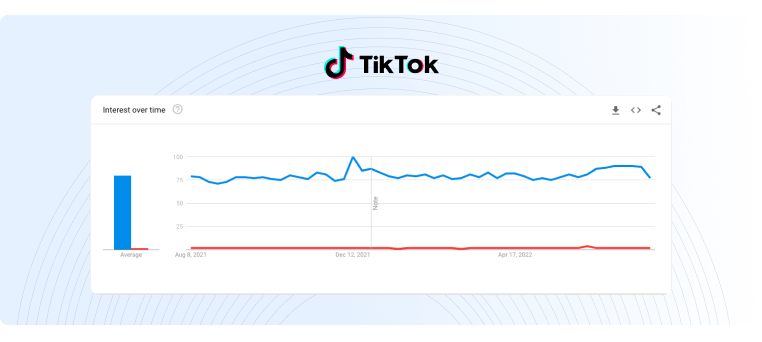 What’s even more fascinating is that TikTok is becoming the new search engine - to some even preferable to Google. The reason behind this is our attention span. It’s shorter, and we’re lazier, giving preference to a) visually more appealing learning styles and b) getting tired of unsatisfactory Google results.
What’s even more fascinating is that TikTok is becoming the new search engine - to some even preferable to Google. The reason behind this is our attention span. It’s shorter, and we’re lazier, giving preference to a) visually more appealing learning styles and b) getting tired of unsatisfactory Google results.
Cisco reports that in 2022, 82% of all global internet traffic will be video. This means that if you're not using video as part of your social media marketing strategy, you're missing out big time. So make sure your videos are short and to the point, fun, and most importantly, relevant to your target audience.
2. Social Selling for Direct Customers
Redirecting a user from your brand’s social media profile to your official website to make a purchase may just be one step too much in the buyer’s journey. That’s why social selling - or selling your services or products directly from the social platform - is growing in popularity.
Marketers all over the world are embracing the fact that a deal has better chances of being closed when potential customers are reached anytime and anywhere. In fact, eMarketer reports that sales in retail social commerce reached $27 billion last year, and this number is expected to reach $56 billion in 2023.
This is why GaggleAMP has made it our business to help your sales team meet customers where they are by providing the platform to help them tap into key conversations happening on social media. Social selling helps build bigger pipelines, better relationships, and get faster closing rates with our social selling software. Using software like GaggleAMP, you can send any member of your team the exact post you need them to comment on rather than leaving them up to finding these opportunities themselves.
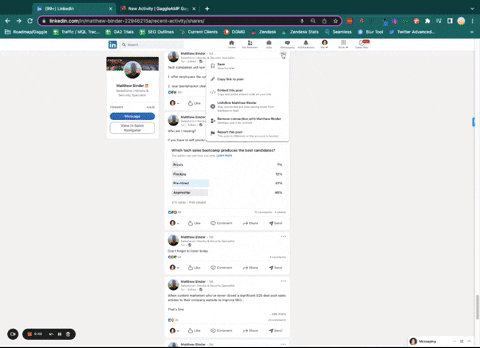
3. Brands Advertising to Older Generations
Inclusivity isn’t just a notion used when talking about gender or race. With more and more baby boomers becoming internet savvy, age has become another building block of the buyer persona.
How surprised will you be if I told you that there are 70+ “grandfluencers” who are getting more and more followers on social media platforms? Some brands are even using their social media presence as part of their marketing strategy.
Although success depends on the type of products/services your brand is offering, bridging the generation gap can turn out to be a whole new pool of selling opportunities. No wonder, as 50+ adults spend an average of $7 billion dollars a year on online purchases.
So, when you’re brainstorming for a new social media strategy, set some time apart for the not-so-obvious age group as potential customers. You’d be surprised by the results.
4. Instagram, Twitter, and Facebook Aren’t Going Anywhere
No big surprises here, but we’re also not talking just about the everyday social media users. According to Hubspot, 70% of B2B brands are planning to increase their investment on Twitter and 63% of them plan to strengthen their Instagram presence. Don’t count Facebook out for B2B either. 49% plan to enhance their presence on this consumer-friendly social network.
Source: 10 Social Media Trends Marketers Should Watch in 2022 [Data + Expert Tips]
Pro Tip: No matter how many new social media trends appear each year, don’t forget to nurture your already winning social media channels.
5. Influencer Marketing and Employee Advocacy
Another one of the hottest social media marketing trends is nothing new on the radar, but will definitely continue to dominate the social platforms is influencer marketing - and this includes the micro and nano influencers too.
People trust influencers more than they do brands, so it comes as a no-brainer that these two have agreed to create a partnership. The Influencer Marketing Hub’s benchmark report says that more than 75% of marketers plan to set aside a budget just for influencer marketing in 2022.
What’s important here is to decide which (type of) influencer would suit best for your brand. Consider these questions before making your choice:
- Do you need a bigger reach or greater engagement on social media?
- Would you benefit more from a generalist influencer or someone who’s deeply dived into your niche?
- How many influencers do you need?
- Are their and your brand’s values aligned?
Don’t forget your biggest, most influential influencers — your employees. Using an employee advocacy platform can help get your message in front of those you’re likely to engage with while building the authority of your employees. Not to mention, people trust people more than they do brands.
6. Outsourcing Your Content to a Creator
This trend is closely related to the previous one, as creators and influencers are very often used interchangeably. I decided to divide them into two separate trends so as to give respect to all content creators there who aren’t… well, influencers.
I’m talking about any content here: writing copy, image design, video creation, and production - basically all those incredibly talented people who sometimes work for the influencers you know and love.
According to SignalFire, the number of content creators has reached 50 million, with $800 million invested as venture capital year after year.

Source: SignalFire’s Creator Economy Market Map
The main difference between influencers and content creators is that the former focus on building their own brand and audience through social media relationships, while the latter produce content specifically designed for your brand.
Where influencers would be a great collaboration for increasing your brand awareness or reaching a specific audience, you’ll need content creators for high-quality and professional pieces of content that will serve as proof of your expertise and brand authority. Furthermore, they stay in the shadows while they put your strongest assets as a brand in the spotlight.
That said, businesses are becoming more aware that a budget for influencer marketing is not the same as for hiring a content creator - if they want to stay in the marketing game, that is.
7. Employee Advocacy and Dark Social on the Same Team
Most marketing teams believe that employee advocacy is only about creating content for employees to share. This is the starting point, though. If you want to make a serious impact - and revenue - incorporate dark social in your marketing equation.
The term is used to denote privately sharing content - think people sharing/copying links to your website in private chats, text messages, or emails. Although this is difficult to measure, it’s where real trust and persuasion come into play. People are willing to buy because they’ve built solid relationships with people from your company, not just because of your website. Not to mention, in closed groups (think LinkedIn or Facebook Groups), there are always, always silent observers.
Employee advocacy amplifies dark social. Employees are encouraged to share insightful, educational, and useful content throughout their social networks, and to engage with others where they see fit. To make sure you’re getting the most out of your people, always:
- Encourage them to post their own opinions and advice
- Engage with their content
- Re-share their posts to the company’s social media accounts
- Create a culture of support, acceptance, and encouragement where employees will feel free to be creative
- Lead by example — be active, engaged, and understand how your responses are valued within a community
- Use gamification by giving away prizes people want
8. Your Brand Will Be Nothing Without Social Listening
No, it’s not eavesdropping - it’s just tracking specific social media activity. Social listening tools can help you track (and find):
- Mentions of your brand, products, or services
- People related to your brand (think customers or evangelists)
- Hashtags
- Terms relevant to your industry
This method will help you strengthen your social media marketing strategy by eliminating the possible flaws and doubling down on the tricks that actually work.
According to SocialMediaToday, the top items companies use social listening for are brand sentiment, brand awareness, and industry trends:
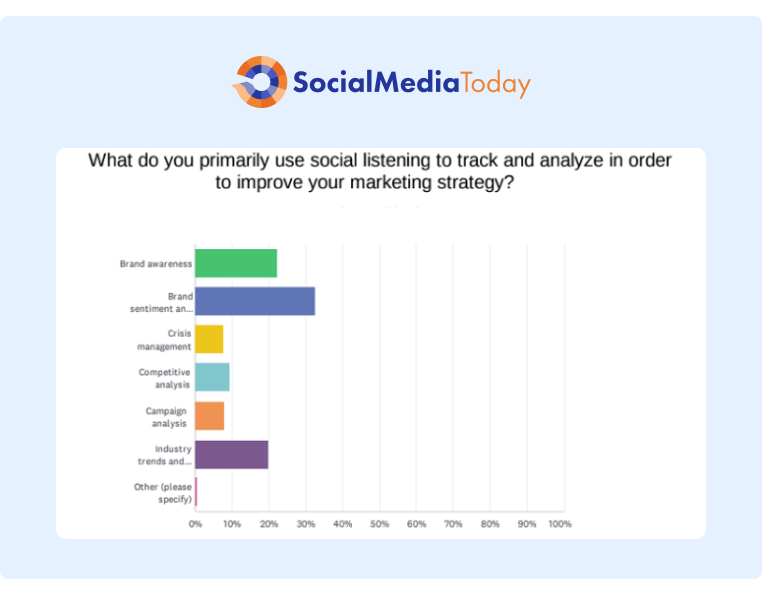 Source: The State of Social Listening in 2022 - Report
Source: The State of Social Listening in 2022 - Report
This is important because unhappy customers take it to social media. The brand selling that product can learn a lot about where they’ve gone wrong and what they can do to make sure it doesn’t happen again.
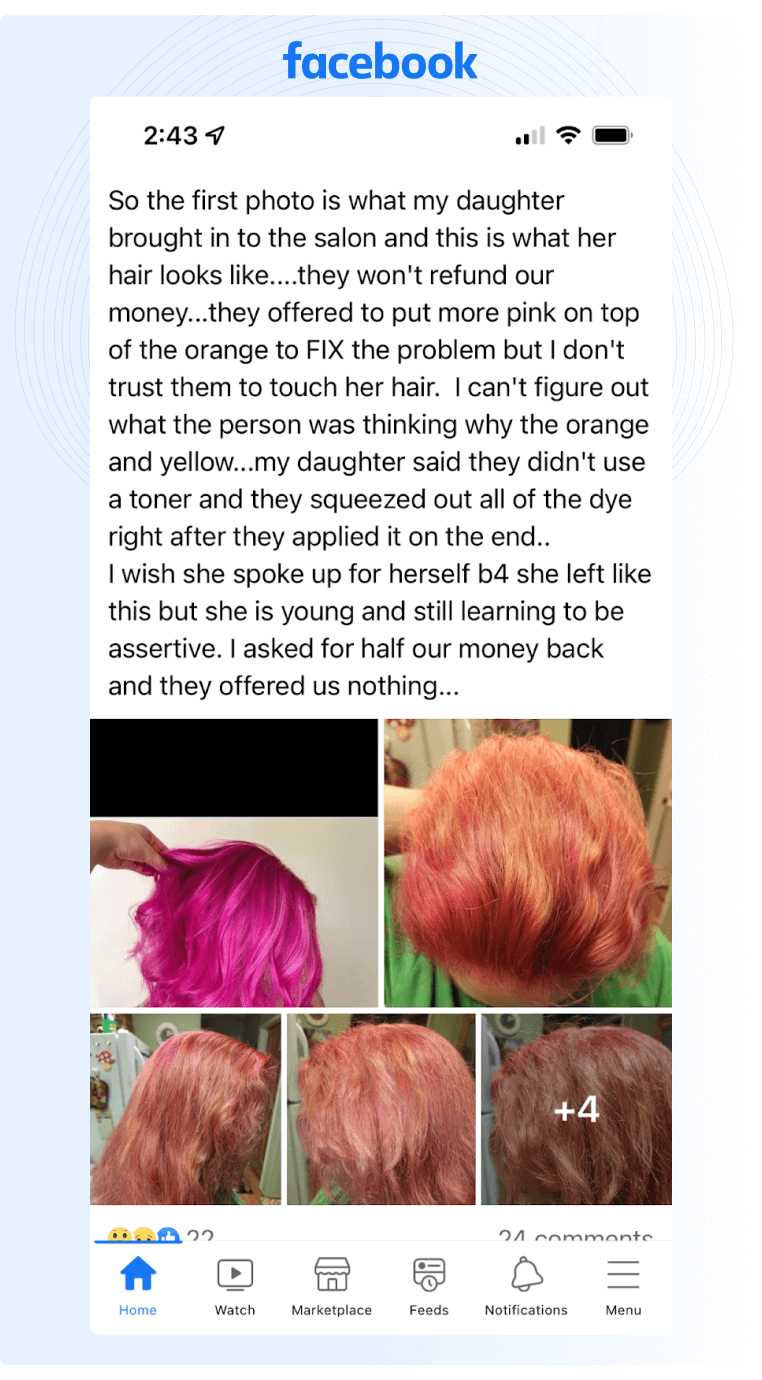
Example complaint from a customer on a local Facebook page (name redacted)
9. Local Targeting for Some Serious Local Attention
Just like local SEO, local targeting allows you to connect with your ideal audience based on their current location. It combines IP addresses, browser cookies, WIFI triangulation technology, and information willingly given by users to show you hyper-local targeted media.
What does this mean in social media terms?
It means that you can use almost any social media platform for your marketing strategy by using geo-tagging (i.e. adding locations to your posts for better local reach). You may have noticed this happens already when you travel or even hyper-local targeting based on where you live.
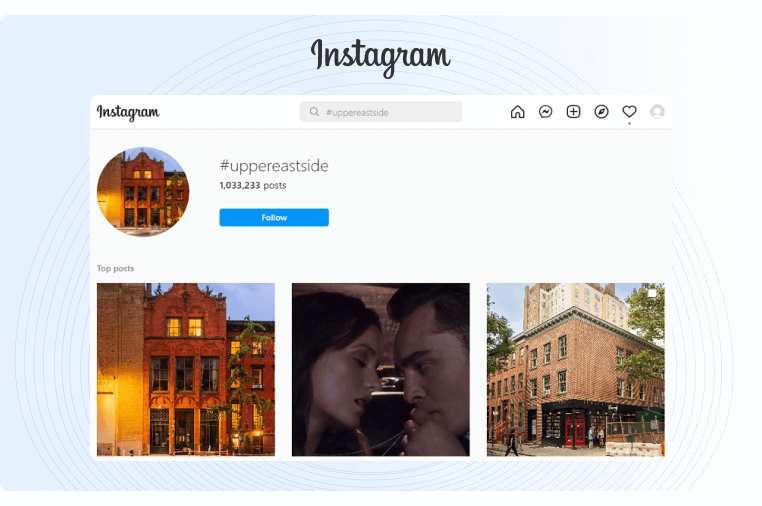 The beauty of this method is that it costs way less than the traditional advertising forms whilst offering you the best end-to-end customization and personalization on a silver platter. Businesses are growing more aware of local targeting too. The global local analytics market jumped from $16.15 billion in 2021 to $18.75 billion in 2022 with an expectancy to grow to $32.35 by 2026, according to ReportLinker.
The beauty of this method is that it costs way less than the traditional advertising forms whilst offering you the best end-to-end customization and personalization on a silver platter. Businesses are growing more aware of local targeting too. The global local analytics market jumped from $16.15 billion in 2021 to $18.75 billion in 2022 with an expectancy to grow to $32.35 by 2026, according to ReportLinker.
10. User-Generated Content Will Keep Its Popularity
Probably the cheapest, easiest, and the most trustworthy technique you can use for your brand marketing. User-generated content (UGC) is another trend that’s not quite new, but it’s been so effective that businesses all over the world show no signs of dropping it.
A UGC report done by Tint states that 76% of consumers bought some kind of a product just because someone else had recommended it, while 72% believe that testimonials and reviews of products are more credible when submitted by customers than when the brand talks about them.
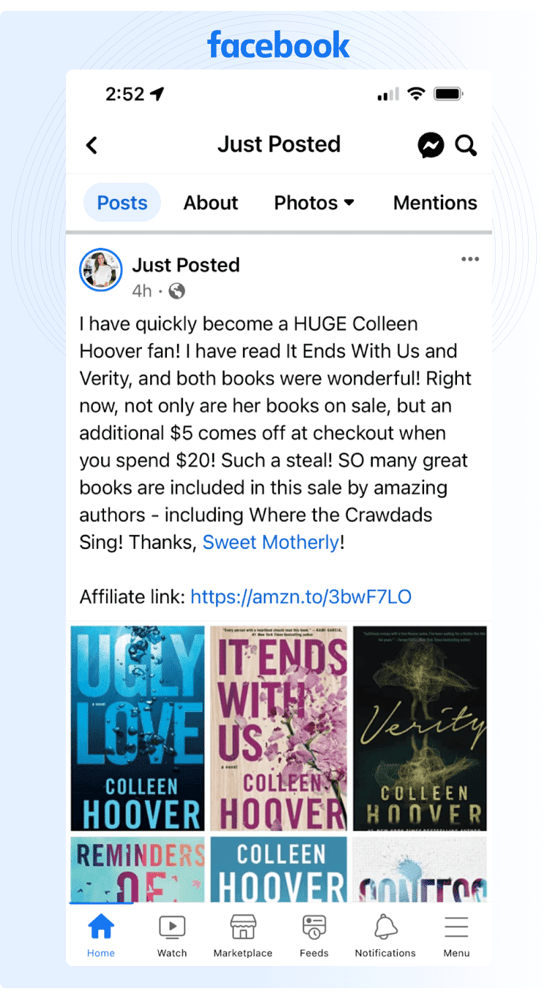 UGC is one of the favorites because it costs the company nothing to create it as it’s generated completely by satisfied users a.k.a. brand promoters. It’s also flexible in nature so you get to choose how you want to use it: will you integrate it within your marketing strategy together with other methods or use it as the sole marketing content.
UGC is one of the favorites because it costs the company nothing to create it as it’s generated completely by satisfied users a.k.a. brand promoters. It’s also flexible in nature so you get to choose how you want to use it: will you integrate it within your marketing strategy together with other methods or use it as the sole marketing content.
For example, Dove encourages its customers to create their own content about personal experiences with the brand.
So, no matter if you’re a complete rookie to UGC or have done some marketing with it, make sure you use it often because it does to your image what moisturizer does to your skin.
11. Augmented Reality
You’re familiar with the filters that can add cute little whiskers to our photo or make us look 50 years older, right? Well, that’s one use of augmented reality technology (AR) - as opposed to virtual reality (VR) where your real-life environment is replaced with a simulated one.
Now, what has that have to do with social media marketing? It turns out, plenty. According to the latest statistics, using AR (i.e. 3D technologies while online shopping) can increase conversion rates by 40%.
The idea behind this is that customers get to see, for example, how the specific hat would sit on their head or how much brick red lipstick shade goes with ginger hair. This way, the purchase satisfaction is almost guaranteed, thus improving customer experience (and reviews) big time.
Check out this example of AR used in marketing by IKEA:
 Source: IKEA Launches Augmented Reality Application
Source: IKEA Launches Augmented Reality Application
ProTip: If you haven’t started with AR yet, try Snapchat or Instagram. They’re the most popular platforms for using augmented reality. It will give you the chance to test the waters and see what consumers will have to say about your products.
12. Customer Service on Social Media
Since online communities are a place where people connect and share experiences, it’s only logical for you as a business to meet them where they dwell the most. In fact, it’s so logical that even statistics back this up - 80% of consumers like to contact brands through their social media channels.
@AmericanAir, Where'sMySuitcase has my luggage but has failed to deliver it. I need it!
— Lola brookes (@BrookesLola) August 3, 2022
Customer service on social media is directly related to the social commerce mentioned above. I mean, if you’re selling services or products directly from social media, the decent thing to do is to have a representative to deal with any issues that might arise from the purchase - again, directly on that social channel.
And when I say representative, I don’t mean just the humans - we never discriminate. Chatbots have become the faithful sidekick of any well-structured website and can help solve common questions before they escalate.
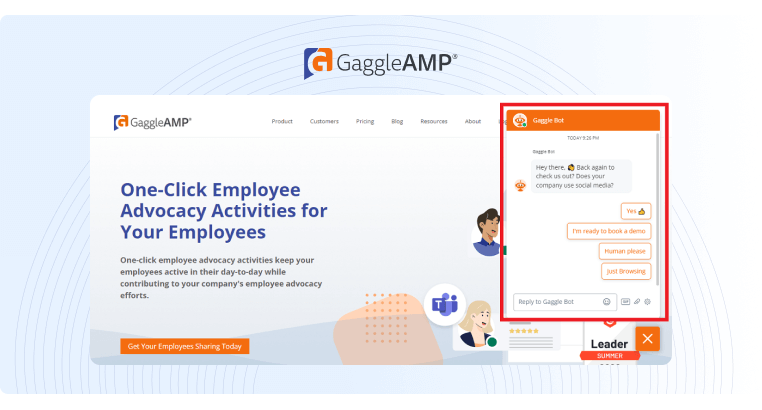 If a chatbot is doing the heavy lifting, you’ll likely have control to let the bot do as much (or little) of the heavy lifting as possible.
If a chatbot is doing the heavy lifting, you’ll likely have control to let the bot do as much (or little) of the heavy lifting as possible.
Let’s Wrap It Up
We’re experiencing huge climate changes and I’m not talking about global warming. The business climate - as if that’s a surprise - is spinning faster than a dreidel.
The biggest trend to watch for is definitely the rise of TikTok as a business social channel and the hunger for short-form video content. Combine that with active usage of the other well-established platforms and their influencers, some quality customer assistance, and actually listening to what consumers are telling you - and you’ll be on the right track with your brand.
Although nobody can exactly predict how these social media marketing trends will unravel in the social media landscape in the future, or which new ones might overcome them, I can confidently say that the 12 mentioned in this article will give your brand the boost it needs for even more lucrative rest of the year.










